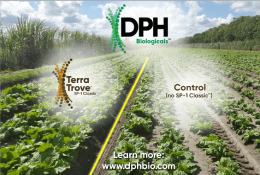CropLife Retail Week: Nutrien Mine Tour, Farm Loans, and Remembering Ag-Chem Equipment Founder Al McQuinn
Eric Sfiligoj and Lara Sowinski discuss visiting a potash mine, farm loans, and the passing of ag technology legend and Ag-Chem founder Al McQuinn.
Subscribe to CropLife Retail Week
*Below is a partial and edited transcript:
Eric Sfiligoj: Hello. Welcome to another edition of Crop Life Retail Week. I’m Eric Sfiligoj, editor of CropLife. Back in office again. From a trip which I will talk about shortly. But before we get to that, also welcome back to the program, Lara Sowinski. Lara, how you been?
Lara Sowinski: Fine. Thank you. Is this 501?
ES: This is the 501st episode of the show. Yes. We’re rounding the corner and heading towards a thousand, you know, nine, nine years from now, if we’re still here, we have the long white beard and, you know, the cane. And I’ll be talking about how we used to record this thing uphill both ways when I was a kid.
I was privileged to join with our friends at Nutrien up in Saskatoon, Saskatchewan, Canada. So for the past four days, because we were recording this video, I spent some time up there in Saskatoon, and I got the chance to visit one of the Nutrien Potash mines. The land mine, which has been around now for 65 years.
The mine earlier this year celebrated its 65th anniversary of operation. That was a fascinating journey, Lara. We got into a lift and we went down and down and down. We went down about a mile, underground. And we were in a layer of rocks and minerals that were laid down approximately 350 million years ago, back, way before the dinosaurs, they estimate that this layer of material was put down, you know, because of continental drift, that this layer was actually somewhere near where Peru is today, on the world map.
And then it slowly over the last 350 million years, worked its way up north to where it now rests in Canada. And, you know, the mine itself, they mined this rock using these big blower machines. And it makes these nice little circular patterns in the rock around it. And then the rock is, you know, the crushed rock is sent on a conveyor belt and it goes to a mill and it goes through a water process.
And I’ll actually show a little visual. This is what the rock looks like originally. This contains salt, clay and of course, potassium. The potash, which is what everybody is looking to get out of it. So this rock, then six hours later will look like this. And this is a concentrated pellet of, potash, which they call a chick lit, which in a, you know, I don’t remember the gum chocolates, but they look it looks remarkably similar.
So, but like I said, a six hour process from one to the other, and then that goes out to, you know, ships and car, I mean, trucks and ships. And it sent all over the world to be used as, dry fertilizer, to get the crop nutrient nutrition in the fields so that the crops will have better intake and uptake of their water.
LS: That’s so cool. That’s a great field trip. That’s awesome.
ES: Yes. And if you ever get a chance, I mean, again and and, you know, you do have to wear a lot of safety gear. I mean, you know, I, I actually I felt a little bit, you know, when I was putting on all the PPE material, I’m like, I empathize for being a knight during the Middle Ages because it it felt like you were putting armor on, basically.
But again, the one thing about a potash mine is because it’s mostly, you know salt, that’s floating around in the air. It’s not dirty like a coal mine would be. Basically, you just kind of, you know, the temperature stays about 80 degrees the whole time. You’re down under the ground and you may sweat a little bit.
And when you get back into service, you kind of your little, little salty, you know, but if you worked in the yard in a summer day in Texas, I’m sure, a little bit of sweat salt is, not unusual. Yeah, it almost sounds therapeutic. Okay. It could be very, very well. Could be. So, again, my thanks to my friends at Nutrien for inviting me on that trip.
I really had a great time learning all about the potash mines and, everything that goes into, to actually getting the crop nutrients from the ground to the field, where it’s then used by the growers to make the crops that we all rely on. So, yeah, that’s great. There’s, no substitute for seeing things firsthand. And appreciating the scale and what happens and timing and such.
And one other thing of course, you know, besides the mine tours, since we were, you know, we had access to Nutrien and all their key people. I actually did a video clip. There was a gentleman there, Paul Bonnet. He’s the senior director of digital agronomy and data science for Nutrien AG Solutions.
And at one point, Paul gave a presentation where he’s talking about technology in agriculture and particularly in agronomy. And he was talking about our favorite, one of our favorite topics, of course, artificial intelligence. Paul, in this video talked about how his team kind of looked at AI and its potential uses in agronomy.
And here are the four things that his team came up with that I will be useful for going forward. So here’s that clip of Paul.
Paul Bonnet: At least four areas recent short term that we see artificial intelligence helping quality. We don’t see artificial intelligence necessarily placed them right. This we see that say 8 to 10 new products and this is just for ideation beginning to occur.
First is that we can reduce this crop, say by huge amount of data. And we could build at reduced 16 pages of data around the clock on that to see that crop results. The more security that one of the things we could be looking at is, how can we feed that into a fast language model and bring that down to 40 what it points across in a human readable sense.
So massive amounts. I noticed that those who were at the how to convert that into something which would be impactful for a consultant for the second least. Yeah, all around labor. And so but I do that to try to get both socks and a top my team we do the second the essentials, which is a three day intensive on the innovation farms.
The consultants we try with 200 different subjects, submission access this year. But across that tech world, however. Yeah, we need to accelerate that so we feel there’s an opportunity there for, you know, artificial intelligence to really able to add some just to get trained quicker on new technology cost and pass spent. You recall you have to say the third aspect of this is plant use, whether that’s crop protection technology or whether that same technology, although that’s nutrition, the ability to actually understand, benefits.
Understand what you can use our product safely, understand what things you want to combine with that product to maximize its use. And then the final aspect is, yeah, agriculture is data is always being messy. No conflicts. There are PDFs, there are multiple formats. There is a great opportunity to use this technology, suck that data in at, transform it to standardized.
You can done with dataset. You can use go but it’s time for solution for the practical uses that we see with artificial intelligence. So when you call me perspective, there’s loads of others on the operational side, logistics side. But when it comes to calling me, how do we feel this technology has massive benefits around training data, access to data, interpretation.
ES: And so that’s what Paul Bonnett from Nutrien had to say regarding AI. Again, Lara, he mentioned data, you know, cleaning up the data and, and putting it into a format that is going to be then, you know, and more manageable for the humans out there like myself.
And, I thought that was a very important point to point out. And again, labor, you mentioned labor. And we’ve heard about labor over and over and over again. And what I might do for labor. But, you know, his big takeaway was that it will not replace the human element in agronomy, but it will definitely help complement it.
I think he made a joke saying something that if we get to the superintelligent AI that probably humankind wouldn’t be around to utilize it. So it. Yeah, that’s actually it sounds about right. So what do you have to share this week before we dive into our last item?
LS: Well, I guess there’s no way to sugarcoat some of this news. However, I just, it certain aspects of this news item caught my attention. This is a, Our friends over at Agriculture Dive, did a recap of a recent report from the Federal Reserve Bank of Kansas City regarding, farm loans and, not surprisingly, the number the volume of new operating loans has increased, since, and at the fastest pace since 2017.
And another, aspect of this is that the first, for the first time in at least two decades, loans larger than $1 million made up the majority of this lending volume. Mostly small and medium sized, loans, are what’s going out. And, according to the news report here, higher lending from smaller banks stands in contrast to what was seen coming out of the pandemic, when lending activity declined at smaller lenders and increased at larger institutions.
So loan volumes at smaller institutions began increasing, last year. And this year, according to the report, of course, a glut of corn and soybean, is contributing to this. Let’s see, deteriorating environment is also, distancing, advising growers from buying new equipment and making other upgrades. So, you know, as we’re seeing and feeling and, you know, certainly confirming with, those folks that we talked to day in, day out.
Yeah, it’s really, really tough out there. I know, you know, kind of internally everything we’ve been talking, you know, the questions were, gosh, how long is this going to last? When might we see some bright spots? And, I think you know, it. Maybe it was you. A couple other of our colleagues said maybe at least, kind of this environmental, you know, the first half of next year’s over or something.
So, I don’t know, it’s just it’s tough. It’s tough to see these things. It’s very disheartening. You know, we know that when we talk to people, just how tough it is out there, compounded, with the farm bill that’s, in limbo right now. So, yeah, just kind of tough all the way around, you know? Oh, I get it.
ES: You’re right. And and again, the folks that I talked to at Nutrien, we, we talked about that a little bit too. And, you know, they’re, they’re anticipating you know, they’re, they’re gearing up for some, some less than stellar times. But you know, again, they do see some positives on the horizon. I’m sure we’ll get to that in some future videos now.
So, hey, some somber news to share with our viewers. Sure. There are several people that watch our program, and in agriculture who are familiar with the name Allen McQuinn. He was the founder of AgChem Equipment and, a very, very long fixture in the ag industry, ag equipment side of things, particularly, sad to report that Allen McQuinn did pass away on October 23rd, the age of 93 years old.
And as I said, you know, Al was well liked by everyone in agriculture and, and particularly the city of Jackson, Minnesota, where the AGCO folks who eventually purchased AgChem back in the early 2000, there’s they still have their Fendt Lodge there and, big production facility. And the mayor of Jackson, whose name was Marcus Pulse, said that, Jackson lost an iconic member of its community who helped make Jackson what it is.
And without McQuinn, Jackson would not be the community it is today. So that’s what he had to say. I know on a personal note, I met Al several times over the years, working in the business. And, one of the my favorite stories about him is, you know, as Al got older, as, you know, as we tend to do, sometimes we need a little assistance walking around.
So Al had a cane, very nice wooden cane. But Al didn’t always need the cane to walk. He did have it, though. But he apparently had a bad habit of leaving at places that he was hotels or places he was visiting. So he actually had, the information for himself is his home address and his name put on a little plaque and the bottom of the cane saying, if found, please return to Al McQuinn.
And, I guess I’m told that there were dozens of instances where the cane was returned to Al, and then Al was, making friends with the person who returned it. But he did have one person tell me that this was Al’s way of sometimes getting people who he was having trouble meeting up with in person to actually meet up with him because he would accidentally leave the cane at a facility or their office, and then they would feel obligated to return the cane to him.
And that’s how he would get the meeting that he was trying to get in the first place. And one of the things you talk about, al McQuinn, you know, back in 2000 CropLife did the Millennium issue, and Al McQuinn was a big proponent of ag technology, and he had this quote, I’m going to read it right from our 2000 report, because I think it’s a very, very insightful one and still applies.
He said, “Technology today is like writing music. There’s no limit to the songs you can write using the seven basic notes, and there’s no limit to where technology can take us.” So great words again. You know, those words are better than 25 but 25 years old. But they still apply today. So, Al, we will miss you. You were you were a great, great person to know. And we are absolutely, very, very touched by all your contributions to the ag equipment marketplace.







